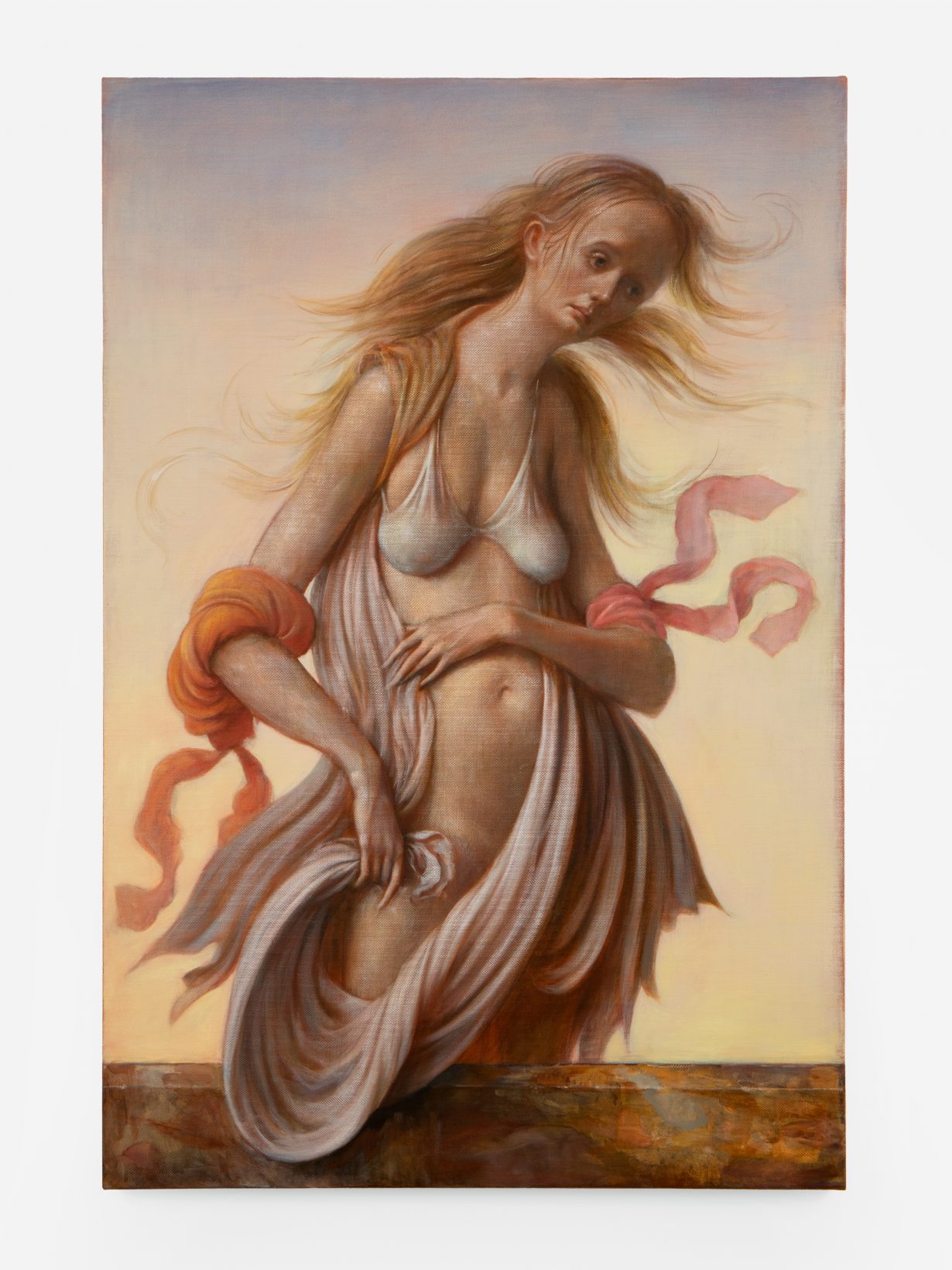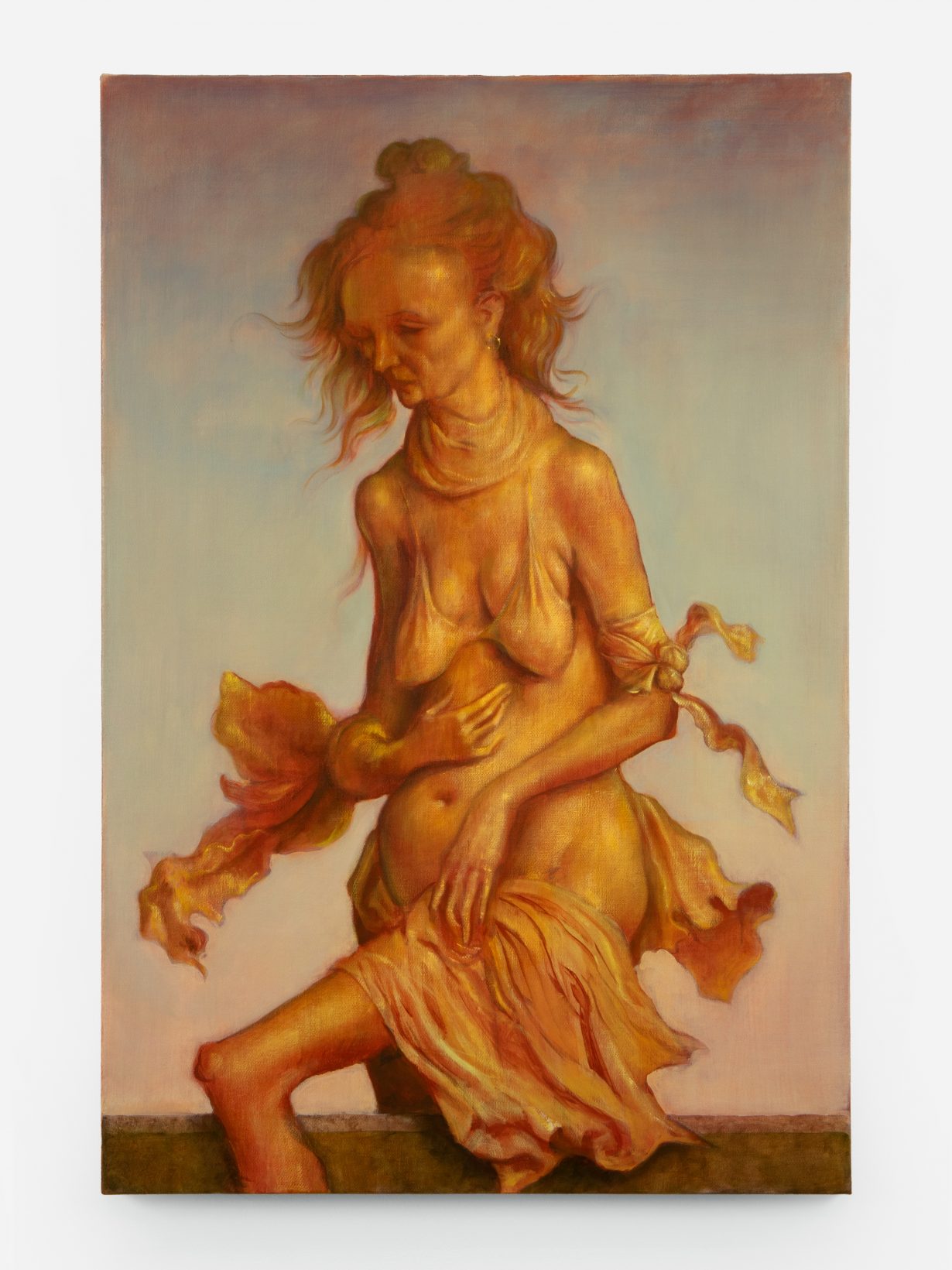In an artworld encumbered by representational politics and moral gesturing, John Currin’s horny, gross and humiliating paintings feel oddly life-affirming

The three paintings that make up John Currin’s show New Paintings at London’s Sadie Coles are disgusting and amoral. And that is why they are so good. All depict bourgeois hippies in a hammy Renaissance style: skinny-legged, wide-hipped white women, their breasts protruding from ridiculous robes or dangling like gourds, bathed in gold and silver light and set against a backdrop of tangerine and lilac. One of them is wearing a turban. Currin’s ridiculous nod to Renaissance ideals is the setup to a bathetic punchline, the lofty high before the low. While the paintings are deeply unflattering, their primary subject is not really the women at all, but the artist’s decrepit libido.
Since his emergence during the early 1990s, Currin has excelled at making grotesque and libidinous portraits of women. (His paintings of men, while amusing, do not emit the same perverted charge.) Over the years this talent has landed him in hot water. American critic Kim Levin famously called for a boycott of Currin’s first gallery show when writing for The Village Voice in 1992. It was to be a position she later revised, writing that his ‘oeuvre reveals an artist whose work is something other than merely misogynistic, sexist, and ageist’. It’s hard to stay mad at a painter who is consistently the butt of his own jokes. When, in 2017, he painted a portrait of the actress Jennifer Lawrence for the cover of Vogue, he pinched her doll-like mouth to create a comical expression of haughty distaste. Lawrence appears to be looking back at Currin and thinking ‘Ew!’

Currin cut his teeth when neoconceptualism was in the ascendency and figurative painting was badly out of fashion. Today, despite figuration having spread across the canvases of the artworld like a particularly contagious rash, his willingness to look his libido in the eye – when many seem to have locked theirs up in the cultural and psychological basement – continues to set him apart. Read the numerous articles on the global decline in fertility rates, and the widespread loss of sex drive, and you will be deluged with reasons why the libido may be becoming an endangered species: porn sickness, LED screens, plastics, depression, processed foods, parasociality, a culture that issues diktats regarding what and how to desire, a society so simultaneously babying and denaturing that it is turning us all into giant pandas, etc. Whatever the broader constellation of causes, within certain areas of the highly self-conscious realm of contemporary art, the libido risks becoming persona non grata, an entity too embarrassing to engage with openly, too likely to stain a carefully curated self-image, too cancellable to reflect the palatable politics of the day. (Out with the legacy of Picasso, an art-history bro who painted with his dick! In with Matisse, that nice man who painted beauty minus desire…)
Broadly speaking, two categories dominate the market for contemporary figurative painting, both of which tend to shun the murky depths of ‘the drives’ in favour of political and aesthetic taste. The first, which we might call ‘Public Service Announcement Painting’, aims to draw attention to social injustices and right historical representational wrongs – enabling the canon to be reopened so new names may be inserted and new auction records broken – and is by nature a category too encumbered by the burdens of representational politics to risk expressing anything morally unsanitary. New Paintings opened during Frieze, when the walls of London galleries were filled with figurative-painting shows. Round the corner, The World We Make by Amy Sherald was on at Hauser & Wirth, a show that expressly intended to provide positive representation of Black subjects. Ads for the show, which included a painting of two men dressed as sailors kissing – a nice painting that depicts its subjects as bright and good, ethically rather than erotically attractive – could be seen in the London Underground.

The second category is what Alex Greenberger called ‘zombie figuration’, a new mode of dead artmaking that builds upon the earlier curse of ‘zombie formalism’, a term coined by Walter Robinson in 2014 to describe the rise of empty commercial painting that dines out on the corpse of modern abstraction. Zombie figuration is a technically adept, magpie-eyed, graphic-design approach to painting, in which artists aggregate disparate imagery. Greenberger uses the work of Emily Mae Smith as an example, a painter he describes as having ‘gotten an unlikely number of artworks out of no more than re-creating famous paintings with the human subjects replaced by broomsticks’. Here, a belief that meaning is produced via the fusion of visual tropes creates a type of painting that actively avoids interiority, functioning instead as a luxury moodboard.
Against this backdrop, Currin’s horny, gross and humiliating paintings are oddly life-affirming. They have no lesson to teach, nor have they been subjected to the deadening logic of ‘moodboard mind’. By letting his twisted libido out of the basement and into the light, his paintings express something of what it is to be human. As a consequence, they connect with a quality once sought-after by painters and latterly much neglected: spirit. A sick spirit, undoubtedly, but a spirit nonetheless.
New Paintings at Sadie Coles HQ London, through 26 November